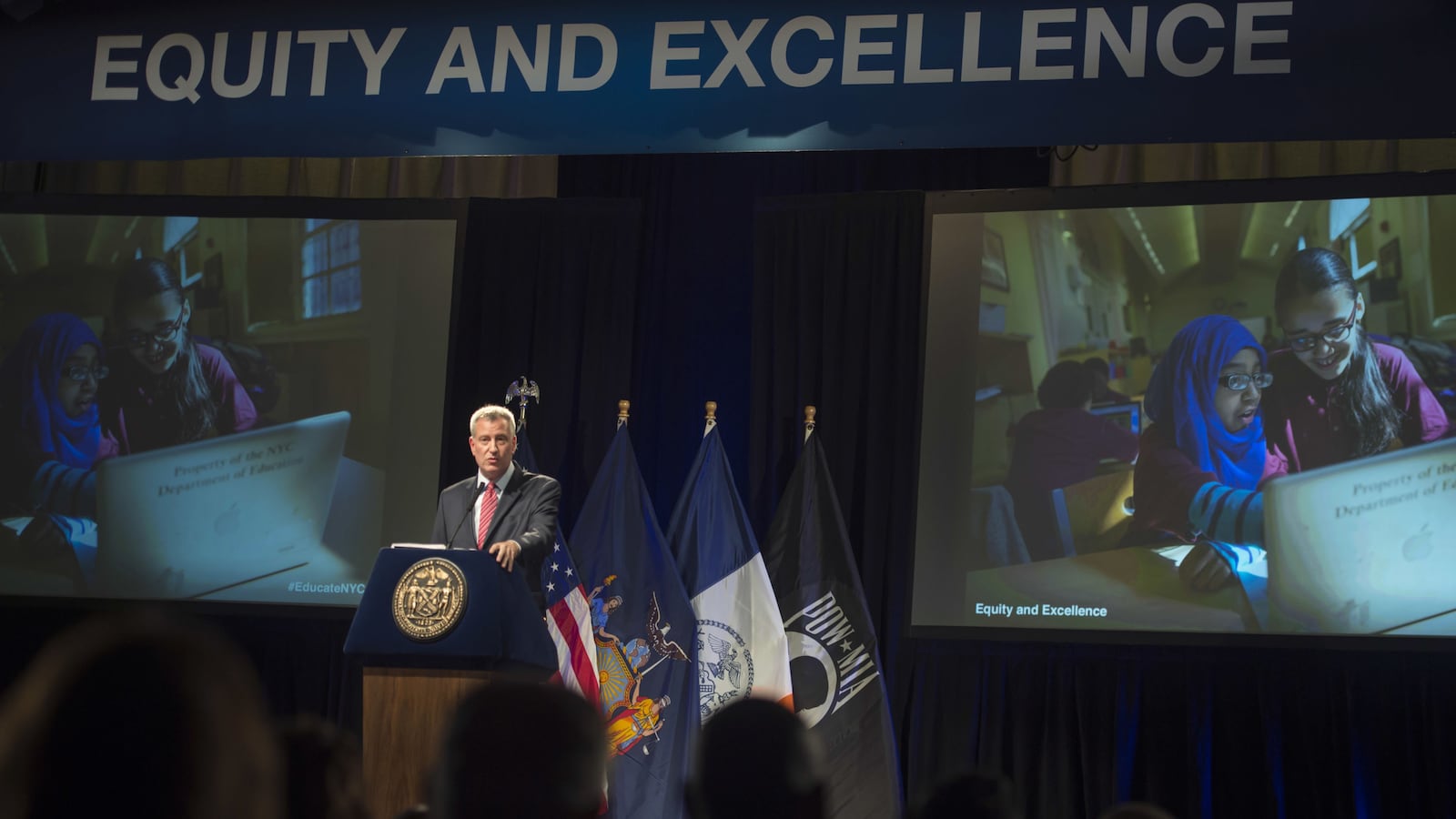The city has given the 94 troubled schools in its expensive new improvement program a special pass: They have three years to hit academic targets that other schools must meet in one year.
Under Mayor Bill de Blasio, every school in the city is assigned annual goals that take into account how needy its students are. But unlike other schools, the 94 struggling schools in the “Renewal” program won’t get new, harder goals every year.
Instead, they have until 2017 to achieve goals they received in 2014. In the interim, they must reach benchmarks that are a fraction of the size of a typical school’s.
The city has previously refused to release lists of the goals it gave Renewal schools, and education department officials have not publicly discussed how they were created. In response to questions from Chalkbeat on Wednesday, they acknowledged that the Renewal goals were one-year targets spread out over three years.
The officials insisted that the Renewal schools, which serve a disproportionate share of needy students and have struggled for many years, require the extra time to reach their final targets. Several people who work in the schools — which could face closure or other consequences if they fail to achieve the goals — said they agreed, calling the targets “reasonable” and “reachable.”
“I don’t know where those numbers came from,” said an administrator at one school, “but we were pleased that they were as low as they were.”
The goals raise questions about the extent and pace of change that education officials expect to result from the nearly $400 million turnaround program, which de Blasio promised would spur “fast and intense improvement” at these bottom-ranked schools. Despite an infusion of support services for students and training for teachers, the improvements may be more modest and slower to materialize than the mayor’s rhetoric would imply.
The special accommodations also suggest that the city’s annual goal-setting formula could not account for the grim condition of the Renewal schools, or that officials adjusted the targets to help ensure that these much-scrutinized schools would hit them.
“Either their current goals are unrealistic,” said Kim Nauer, education project director at the New School’s Center for New York City Affairs, or officials are “hedging their bets for a press release two years out.”
The customized annual goals the city has given schools since 2014 center on attendance, state test scores, graduation rates, and class credits. They are based on the past performance of schools that serve students of similar demographics and skill levels.
The education department used that same formula to calculate goals for the Renewal schools, which enroll a higher-than-average share of students who are still learning English, live in temporary housing, or have disabilities. But officials decided that even though the formula factored in the schools’ high-needs students, the resulting goals still had to be stretched out over three years to be attainable.
“Whatever system they used to project targets for each school,” explained a person who works with Renewal schools, they “basically said for a Renewal school you get three years to meet that same target.”
For Renewal schools that are performing far worse than schools that serve comparable students, the goals may still be quite challenging to meet. For higher-performing schools, the targets require minimal growth.
For example, Banana Kelly High School in the Bronx must raise its four-year graduation rate from 41 percent this year to 57 percent by June 2017.
But M.S. 53 in Queens only needs to boost its students’ average score on the state reading exams one-hundredth of a level by 2017: from 2.14 to 2.15. It must increase their average math score from 2.03 to 2.12. (Students must score at least a level 3 out of 4 to be considered proficient.)
Other schools started this school year having already hit their 2017 targets.
For instance, Brooklyn Generation School’s final four-year graduation target is 67 percent, yet it posted a 68 percent graduation rate this June. And the middle-school students at the Bronx School of Young Leaders earned an average English score of 2.2 this spring, even as the school’s 2017 goal is a 2.19 average.
Even Banana Kelly, which is still far from meeting its graduation goal, already surpassed one of its 2017 targets this year: 16.5 percent of student met a certain “college readiness” measure, when the school’s final goal is just 6.8 percent.
Eric Ashton, the education department’s executive director for school performance, said in an interview that the agency is still deciding what to do about schools that met their goals early. Officials don’t want to discourage progress by issuing successful schools new, higher targets.
However, he said the “vast majority” of Renewal schools will need to make significant gains to meet their goals. Considering how needy many of their students are, and how long most of the schools have floundered, it is only fair to give them extra time to reach their targets.
“Most Renewal schools have been struggling for many years,” he said in a statement. “We cannot expect them to turn around overnight.”
Aaron Pallas, a sociology and education professor at Teachers College, said many past studies have shown that interventions at struggling schools take several years to bear fruit — and even then, they often produce disappointing results.
Setting modest improvement targets for troubled schools can prevent hard-working staffers from becoming demoralized, he said. It also can serve a political purpose, since the mayor’s critics will be sure to pounce if many Renewal schools miss their targets despite the costly intervention.
“Low-balling the goals,” Pallas said, “is a slightly defensive strategy to fight against that possibility.”


